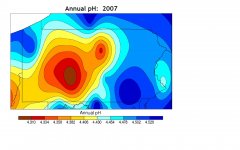I'm dubious of using actual pH. What you really want is MINIMUM pH over the course of a year. And if you really get into it, the critical time period may be when eggs are in the substrate, as I believe eggs are more sensitive to acidic water than are fish.
Take a really infertile (T_Alk < 10) stream. Visit in a rather dry period of late summer. Yes, the pH can look very good indeed. The flows will be low, and what flows there are result from primarily groundwater, which, depending on soil and bedrock structure, could have a fine pH but almost no buffering capability at all. Plus, that soil is actively composting which naturally regulates the pH to be neutral or even a little basic, even if there is no bedrock influence making it that way.
Now visit that stream on a warm, rainy January day, where you have the season's worst acid rain on top of acidic snow (top layer of which can be extremely acidic if it's sat for a while), with a frozen ground underneath. The acidic water never touches the soil or bedrock, and it enters the water as runoff, where it meets a low volume of groundwater, which flowed through soil where composting has stalled. The pH, which last June looked fine, is suddenly dangerously acidic, and it's the eggs that get harmed.
If that stream had any buffering capability resulting from bedrock, the pH drop would not be as severe.
How much alkalinity you "need" depends on runoff rate. Everyone knows that's a huge factor for siltation and flooding, but it is for acidity as well. Even with frozen soils, if you have lots of depresssions in the drainage, scree type rocks, etc., then water collects, melts and freezes multiple times, slowly entering the soil. What does runoff takes the long way, so you don't get that spike. Helps if the soil itself is thicker and more permeable, too. You wind up with healthy groundwater flows even in winter, and less runoff.
On the other hand, if it's shallow compacted soils with a smooth slope right to the stream it runs off, and you get low groundwater flow and lots of runoff very quickly. (human landscaping matters here too, of course). While pyrite is obviously a bad form of rock, this is one reason why shale type bedrocks often produce poor fishing. They are associated with clay like soils and produce "smooth" surfaces throughout the drainage.
So regarding how acidic the water gets, you want to know what the "base pH" is of the groundwater IN WINTER. But you also need to know the alkalinity of that base flow, and, at the worst times, what % of the flow is direct unfiltered runoff vs. groundwater.
T_Alk isn't the whole story, but IMO it tells you more than a summertime pH reading (although, summertime pH is incredibly useful for identifying AMD).
When dealing with acid rain (not AMD), I'd offer that there's a huge difference between, say, a T_Alk of 4 vs. 8. I realize that can look like a small difference when limestoners with 200+ are on the same list. But it's not. It means you can add twice as much acidic water before the pH begins to drop. By which time the remaining runoff is smaller, to be diluted by a larger volume of water already in that stream, and your worst case pH is sure to be quite a bit better.





